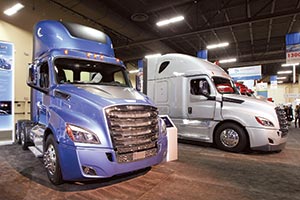Phase 2 GHG Truck Rule to Increase Mileage, Costs

This story appears in the Jan. 9 print edition of Transport Topics.
If results from Phase 1 regulation of greenhouse-gas emissions from trucks are an indication, Phase 2 standards should improve vehicle efficiency further but also add cost and complexity to new trucks, according to an industry webinar on the final rule issued in August.
Panelists for the Jan. 5 Technology & Maintenance Council presentation said the whole rule could be gutted through a “nuclear option” procedure called the Congressional Review Act, but that process is very rare. Presenters also reviewed the schedule of costs and anticipated benefits, and documented how the 2014-2016 generation of Phase 1 diesel truck engines improved in efficiency over 2010-2013 models but were found difficult in terms of maintenance.
TMC is a division of American Trucking Associations.
Glen Kedzie, ATA’s energy and environmental counsel, said regulation of truck emissions is a logical progression from the mileage standards placed on car manufacturers. He said 61% of transportation-related carbon emissions come from cars and 23% from heavy-duty trucks.
All three branches of government — executive, legislative and judicial — have participated in greenhouse-gas issues, “so this is not just an [Environmental Protection Agency] effort,” Kedzie said.
Compared with the 2017-2020 generation of Class 8 sleepers from the end of Phase 1, fuel economy is supposed to improve by 14% in 2021, the first year of Phase 2, and then by about 24% in 2027 when the last of Phase 2’s three stages begins. Vehicle cost also is projected to rise through those stages.
In 2021, the mandate will add about $7,200 to a Class 8 sleeper, EPA has said. The added cost soars to about $13,600 in 2027.
A former EPA attorney, Kedzie said there is room to be suspicious about the estimates.
“Their numbers are never accurate. They usually underestimate costs,” he said.
Kedzie said the rule could be nullified through the Congressional Review Act. If majorities of both houses agree, and then President Trump signs such a bill by mid-May, the rule could be vacated, but Kedzie said that is a very rare event.
Ross Froat, TMC’s manager of engineering programs, said the council surveyed 36 fleets operating almost 48,800 power units about truck and engine performance.
About 77% of fleet managers asked said the Phase 1 trucks made since 2014 were more fuel-efficient than their immediate predecessors. About 17% said there was no change in fuel economy, and 6% said performance actually got worse.
The downside, Froat said, came with serviceability and ease of diagnostics. Seventeen percent of those surveyed said the Phase 1 trucks were better, and 43% said they were about the same. However, 40% said they were worse than their predecessors.
Froat and webinar moderator Robert Braswell, TMC’s technical director, said the survey and related GHG issues will play a significant part at the council’s annual meeting in Nashville, Tennessee, scheduled for Feb. 27 to March 2.
Al Cohn, director of new market development and engineering support of Pressure Systems International, or PSI, spoke about the complexity of the regulations on trailers, which are covered for the first time by EPA. While trucks and engines have to comply in three stages — 2021, 2024 and 2027 — trailer makers must meet those dates plus an earlier stage on Jan. 1, 2018.
Cohn said the basics for most trailers are low-rolling-resistance tires and tire-pressure monitoring. Dry and refrigerated vans also must use aerodynamic skirts and lightweight materials.
Tire-pressure devices, he said, come in two types: automatic tire inflation systems and tire- pressure monitoring systems. An ATIS device actually can pump air into a tire and gets more credit from EPA for its use. TPMS runs continuous checks on inflation with in-cab notification for drivers but does not actually pump air.
For rolling resistance, Kedzie said there could be some difficulty related to the 2027 standards.
“In the outer years, those tires do not currently exist. The agency is hoping the technology will be developed by then,” he said.




